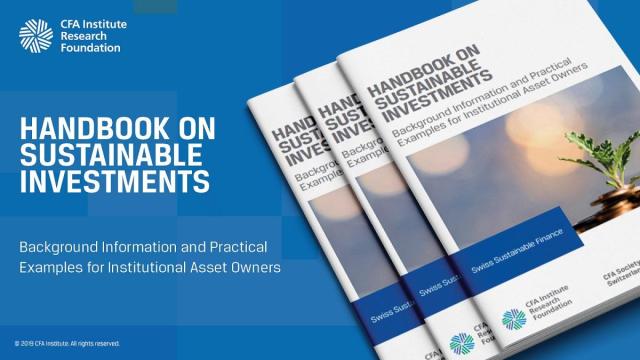[ad_1]
Investors and Managers: Now Join Hands.
As fires continue to ravage Australia, debates among environmental, social, and governance (ESG) investment professionals have been blazing as well.
One LinkedIn commentator, Dr. Raj Thamotheram, observed:
“There is so much ‘sdg washing’ and ‘impact washing’ going on at the moment, it drives me mad. We shouldn’t pretend that buying a share of XXX in the secondary market is changing the world. Change is slow and incremental. [My employer] isn’t perfect, we try to put our best foot forward, that inevitably leads us to be optimistic in describing what we do on ESG. But I try to be as brutally honest as I can. I’m amazed at how many peers say in the PRI reports that they do ESG integration across all asset classes 100%. Really? And if so, what does that actually mean?
“The answers aren’t easy but the challenge is urgent and CEOs of member firms need to mandate corrective action in 2020.
“Is there anyone who really disagrees or is there anyone who thinks that enough is being done today?
“And for those who do agree, what are the top three things PRI could require member firms to do?”
Here is my response:
“Thanks for the post. Great discussion. A couple of thoughts in response.
“1) Greenwashing is inevitable; you put something out there that investors say is important and products will be marketed.
“2) ESG is not impact investing, and while there will be specific impacts, don’t expect them — not to say that there won’t be changes, but these will be driven more by profit motive and less by public capital, so adjust policy accordingly and keep the pressure on as consumers and investors.
“3) Don’t forget about the other two thirds of the world, governments and private companies. The ESG movement harps on the public companies, and misses the other two thirds of production/consumption.
“4) Standards could help, but what would those look like? Any proposals?”
Unfortunately, nobody took the bait on that last one.
So, let’s break down the main issues that the ESG world is concerned about and where we go from here:
1. Investment Products that Don’t Do What They Claim
Intentional ESG, as distinguished from integrative ESG, is another term for impact investing. Included among such strategies are those of the “thematic” and “engagement” varieties.
If investors want to have an impact, they need to make sure their manager knows where they are invested and what the associated impacts of those investments are. They need to make their money work for them.
But they should be wary: Defining success is difficult and expectations must be managed. Even Elon Musk faces significant environmental challenges as he tries to transform the world with electric cars. To have an impact, investors should focus on new companies that are developing new technology and new strategies to build a sustainable economy.
Like it or not, integrative ESG, which considers non-financial factors as risks to stock prices, is investment management. And as with active management, some approaches will work better than others. So the ambiguity and the associated concerns about greenwashing will remain.
Beyond investor vigilance in the manager-selection process, there is no way around this. Questionnaires can help guide such efforts, and investment consultants are developing and deploying their own methods.
The evolution of public investment products will probably move in two directions: extension of the traditional and engagement. With the former, ESG will become just another standard framework for active and index investing, to the point where it may even lose its status as a category. Or maybe the obverse will occur and all investing will become ESG. Either way, it will be, perhaps, a perfect blend of the traditional and the new.
On the engagement front, funds — including and perhaps especially hedge funds — will become vehicles for corporate transformation through shareholder activism. Huw van Steenis aptly described the movement to divest from fossil fuels as a short motivated by the belief that energy sector companies cannot transform themselves. While I tend to agree, I believe divestment campaigns can help propel companies towards that transformation.
2. Urgent (Mostly Climate) Matters that Must Be Solved
Humanity’s impact on the environment is real and scary. Of that there is no doubt. And we may be hitting peak consciousness as to just how large and damaging that impact is.
Most fisheries are depleted by 90%, much of the Amazon rainforest may turn into savannah, Australia is on fire, and the coral reefs may all be under threat by 2050.
As a consequence, the will to take action is growing. Whether that will translate into collective action is another question. What can we realistically expect from our civilization? And how do we best leverage business to address these problems?
Michael Liebreich recently offered a vision of what the path to sustainable energy production might look like, but also put into perspective how achievable the current set of goals are:
“I believe the new decade will see us hit peak energy-related greenhouse gas emissions and start to see a modest but meaningful decline. Just to be clear, we will not see the sort of decline demanded by the Intergovernmental Panel on Climate Change — a 20% cut by 2030 to keep temperature rises to 2C, a 45% cut to remain under 1.5C — but I would guess at a drop of around 5%.
“Clearly that is not enough to put us fully on track to avoid appalling climate change impacts, and by 2030 we will have to admit 1.5C is out of reach. But it will be a game-changer: it will demonstrate to even the most pessimistic that we can bend the arc; it will end the feeling of helplessness and impending doom that has taken over our public discourse; and it will set us up for much more decisive reductions in the subsequent decades.”
3. Disingenuous Companies and Management
A new definition of corporate purpose debuted in 2019. No longer would shareholder primacy be the prime focus, the Business Roundtable announced. Now corporations would work for the benefit of all their stakeholders.
And critics from both sides of the spectrum came out in force. Some of these skeptics felt the nearly 200 CEOs who signed on ought to go all-in and file as B-companies, while others defended the concept of shareholder value.
I agree with both critiques. I’ve never thought these approaches were mutually exclusive, that if you worry about your stakeholders, you can’t also worry about your shareholders or even maintain shareholder primacy. Good business gets done this way. Good business gets done sustainably so that profits can be earned over the long run.
But keeping an eye on management remains essential. Which is why corporate governance will continue to be the chief driver of ESG. Indeed, ESG ought to have been called GES, though it doesn’t quite have the same ring to it, does it?
4. Raising Assets to Have Influence and Generate Fees
Speaking of profits, yes, they are the prime motivator of ESG investing. Which brings us back to the concern about greenwashing.
We have to accept, even embrace, the fact that earning fees and generating profits is what gives us the best chance to make the leap from a non-sustainable and non-circular economy to one that is sustainable and circular.
We accomplish nothing if we as individuals don’t have a stake in the outcome — skin in the game — or if we can’t make it work for ourselves as individual contributors. Public policy has a role to play to help guide, and possibly even help accelerate, that profit motive.
Which brings me to one final point: standards. We need them. Desperately. Better and more consistent definitions, data, and disclosures — what I refer to as the three Ds — will yield better and more consistent results. And will mitigate greenwashing concerns.
A day will come when we will be able to sift through a given manager’s marketing materials and, based on the holdings alone, judge how sustainable the underlying portfolio actually is.
And many of us are working towards that day, whether it’s by measuring and quantifying climate impacts or exploring how asset classes will be reported, indexed, and ultimately traded and owned in the future.
So stay tuned.
If you liked this post, don’t forget to subscribe to the Enterprising Investor.
All posts are the opinion of the author. As such, they should not be construed as investment advice, nor do the opinions expressed necessarily reflect the views of CFA Institute or the author’s employer.
Image credit: ©Getty Images/Andrew Merry
Professional Learning for CFA Institute Members
CFA Institute members are empowered to self-determine and self-report professional learning (PL) credits earned, including content on Enterprising Investor. Members can record credits easily using their online PL tracker.
[ad_2]
Image and article originally from blogs.cfainstitute.org. Read the original article here.





